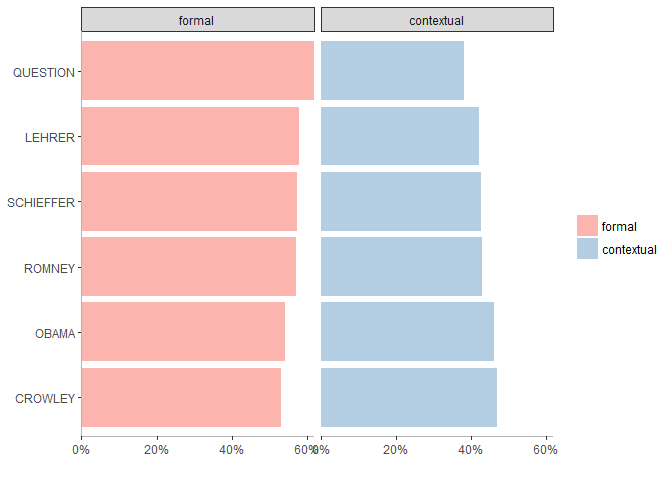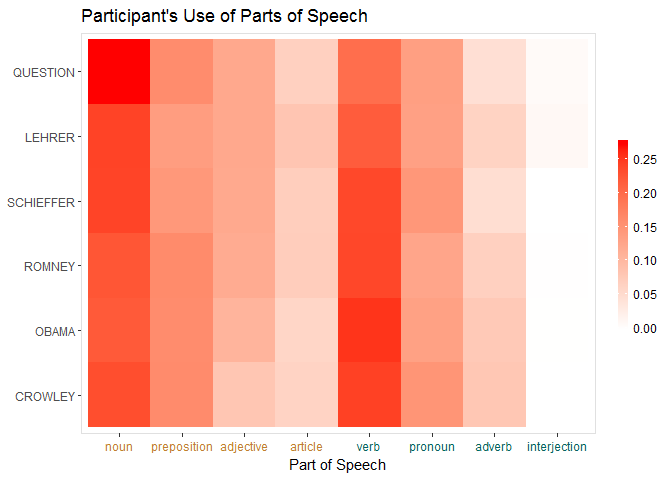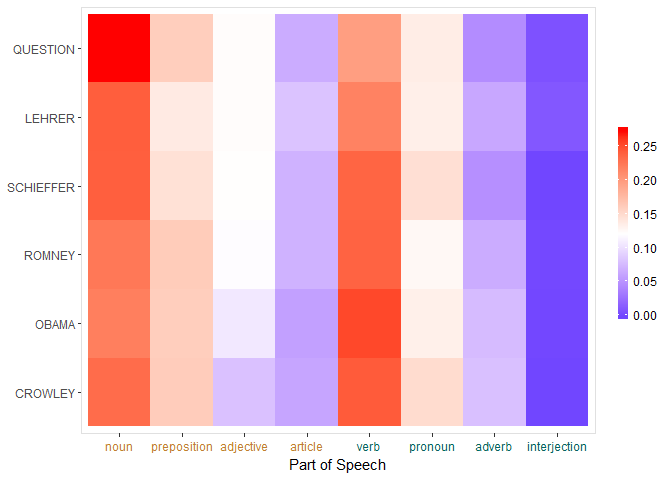formality utilizes the tagger package to conduct formality analysis. Heylighen (1999) and Heylighen & Dewaele (2002, 1999) have given the F-measure as a measure of how contextual or formal language is. Language is considered more formal when it contains much of the information directly in the text, whereas, contextual language relies on shared experiences to more efficiently dialogue with others.
The formality package's main function is also titled formality and
uses Heylighen & Dewaele's (1999) F-measure. The F-measure is
defined formally as:
F = 50(((nf − nc)/N)+1)
Where:
f = {nou**n, adjective, preposition, article}
c = {pronoun, ver**b, adver**b, interjectio**n}
N = nf + nc
This yields an F-measure between 0 and 100%, with completely contextualized language on the zero end and completely formal language on the 100 end.
Please see the following references for more details about formality and the F-measure:
- Heylighen, F. (1999). Advantages and limitations of formal expression. Foundations of Science, 4, 25-56. doi:10.1023/A:1009686703349
- Heylighen, F. & Dewaele, J.-M. (1999). Formality of language: Definition, measurement and behavioral determinants. Center "Leo Apostel", Free University of Brussels. Retrieved from http://pespmc1.vub.ac.be/Papers/Formality.pdf
- Heylighen, F. & Dewaele, J.-M. (2002). Variation in the contextuality of language: An empirical measure. Foundations of Science, 7(3), 293-340. doi:10.1023/A:1019661126744
To download the development version of formality:
Download the zip
ball or tar
ball, decompress
and run R CMD INSTALL on it, or use the pacman package to install
the development version:
if (!require("pacman")) install.packages("pacman")
pacman::p_load_gh(c(
"trinker/termco",
"trinker/tagger",
"trinker/formality"
))
You are welcome to:
- submit suggestions and bug-reports at: https://github.com/trinker/formality/issues
- send a pull request on: https://github.com/trinker/formality/
- compose a friendly e-mail to: tyler.rinker@gmail.com
The following examples demonstrate some of the functionality of formality.
library(formality)
data(presidential_debates_2012)
formality takes the text as text.var and any number of grouping
variables as grouping.var. Here we use the presidential_debates_2012
data set and look at the formality of the people involved. Note that for
smaller text Heylighen & Dewaele (2002) state:
At present, a sample would probably need to contain a few hundred words for the measure to be minimally reliable. For single sentences, the F-value should only be computed for purposes of illustration" (p. 24).
form1 <- with(presidential_debates_2012, formality(dialogue, person))
form1
## person noun preposition adjective article verb pronoun adverb
## 1: QUESTION 155 91 70 38 112 77 26
## 2: LEHRER 182 104 93 62 164 101 48
## 3: SCHIEFFER 347 209 176 102 342 211 69
## 4: ROMNEY 4406 3178 2346 1396 4676 2490 1315
## 5: OBAMA 3993 2909 1935 1070 4593 2418 1398
## 6: CROWLEY 387 269 135 104 405 249 134
## interjection formal contextual n F
## 1: 4 354 219 573 61.78010
## 2: 8 441 321 762 57.87402
## 3: 0 834 622 1456 57.28022
## 4: 25 11326 8506 19832 57.10972
## 5: 13 9907 8422 18329 54.05096
## 6: 0 895 788 1683 53.17885
This will take ~20 seconds because of the part of speech tagging that
must be undertaken. The output can be reused as text.var, cutting the
time to a fraction of the first run.
with(presidential_debates_2012, formality(form1, list(time, person)))
## time person noun preposition adjective article verb pronoun
## 1: time 2 QUESTION 155 91 70 38 112 77
## 2: time 1 LEHRER 182 104 93 62 164 101
## 3: time 1 ROMNEY 950 642 483 286 978 504
## 4: time 3 ROMNEY 1766 1388 958 617 1920 1029
## 5: time 3 SCHIEFFER 347 209 176 102 342 211
## 6: time 2 ROMNEY 1690 1148 905 493 1778 957
## 7: time 3 OBAMA 1546 1185 741 432 1799 973
## 8: time 1 OBAMA 792 579 357 219 925 452
## 9: time 2 OBAMA 1655 1145 837 419 1869 993
## 10: time 2 CROWLEY 387 269 135 104 405 249
## adverb interjection formal contextual n F
## 1: 26 4 354 219 573 61.78010
## 2: 48 8 441 321 762 57.87402
## 3: 240 4 2361 1726 4087 57.76853
## 4: 536 10 4729 3495 8224 57.50243
## 5: 69 0 834 622 1456 57.28022
## 6: 539 11 4236 3285 7521 56.32230
## 7: 522 4 3904 3298 7202 54.20716
## 8: 281 2 1947 1660 3607 53.97838
## 9: 595 7 4056 3464 7520 53.93617
## 10: 134 0 895 788 1683 53.17885
The generic plot function provides three views of the data:
- A filled bar plot of formal vs. contextual usage
- A dotplot of formality**
- A heatmap of the usage of the parts of speech used to calculate the formality score
**Note red dot in center is a warning of less than 300 words
plot(form1)
The plot function uses gridExtra to stitch the plots together,
which is plotted imediately. However, the three subplots are actually
returned as a list as seen below.
names(plot(form1, plot=FALSE))
## [1] "formality" "contextual_formal" "pos"
Each of these is a ggplot2 object that can be further manipulated with various scales, facets, and annotations. I demonstrate some of this functionality in the plots below.
library(ggplot2)
plot(form1, plot=FALSE)[[1]] +
scale_size(range= c(8, 45)) +
scale_x_continuous(limits = c(52, 63))
plot(form1, plot=FALSE)[[2]] +
scale_fill_grey()
plot(form1, plot=FALSE)[[2]] +
scale_fill_brewer(palette = "Pastel1") +
facet_grid(~type)
plot(form1, plot=FALSE)[[3]] +
scale_fill_gradient(high = "red", low="white") +
ggtitle("Participant's Use of Parts of Speech")
plot(form1, plot=FALSE)[[3]] +
scale_fill_gradient2(midpoint=.12, high = "red", low="blue")








